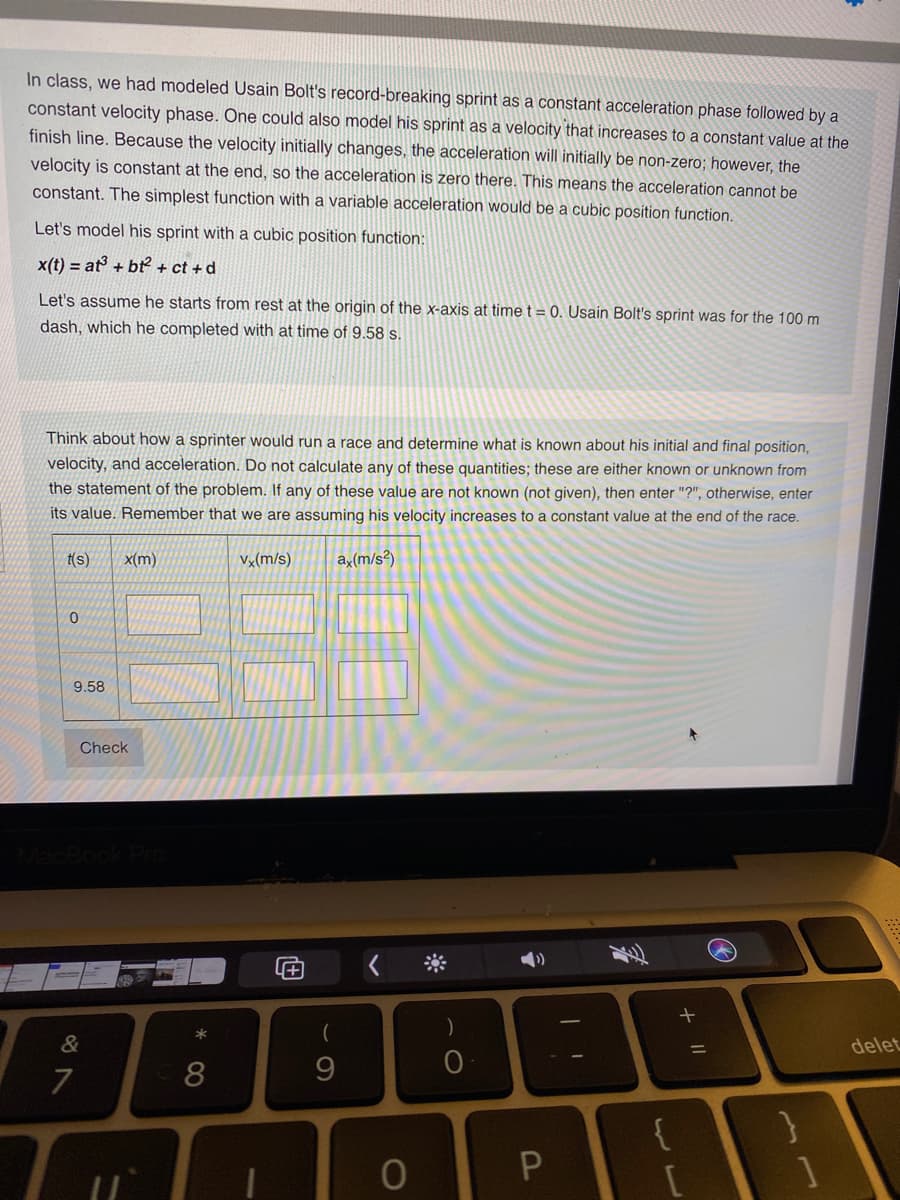In class, we had modeled Usain Bolt's record-breaking sprint as a constant acceleration phase followed by a constant velocity phase. One could also model his sprint as a velocity that increases to a constant value at the finish line. Because the velocity initially changes, the acceleration will initially be non-zero; however, the velocity is constant at the end, so the acceleration is zero there. This means the acceleration cannot be constant. The simplest function with a variable acceleration would be a cubic position function. Let's model his sprint with a cubic position function: x(t) = at + bt + ct +d %3D Let's assume he starts from rest at the origin of the x-axis at time t = 0. Usain Bolt's sprint was for the 100 m dash, which he completed with at time of 9.58 s. Think about how a sprinter would run a race and determine what is known about his initial and final position, velocity, and acceleration. Do not calculate any of these quantities; these are either known or unknown from the statement of the problem. If any of these value are not known (not given), then enter "?", otherwise, enter its value. Remember that we are assuming his velocity increases to a constant value at the end of the race. t(s) x(m) Vx(m/s) ay(m/s?) 9.58 Check
In class, we had modeled Usain Bolt's record-breaking sprint as a constant acceleration phase followed by a constant velocity phase. One could also model his sprint as a velocity that increases to a constant value at the finish line. Because the velocity initially changes, the acceleration will initially be non-zero; however, the velocity is constant at the end, so the acceleration is zero there. This means the acceleration cannot be constant. The simplest function with a variable acceleration would be a cubic position function. Let's model his sprint with a cubic position function: x(t) = at + bt + ct +d %3D Let's assume he starts from rest at the origin of the x-axis at time t = 0. Usain Bolt's sprint was for the 100 m dash, which he completed with at time of 9.58 s. Think about how a sprinter would run a race and determine what is known about his initial and final position, velocity, and acceleration. Do not calculate any of these quantities; these are either known or unknown from the statement of the problem. If any of these value are not known (not given), then enter "?", otherwise, enter its value. Remember that we are assuming his velocity increases to a constant value at the end of the race. t(s) x(m) Vx(m/s) ay(m/s?) 9.58 Check
University Physics Volume 1
18th Edition
ISBN:9781938168277
Author:William Moebs, Samuel J. Ling, Jeff Sanny
Publisher:William Moebs, Samuel J. Ling, Jeff Sanny
Chapter15: Oscillations
Section: Chapter Questions
Problem 14CQ: With the use of a phase shift, the position of an object may be modeled as a cosine or sine...
Related questions
Question

Transcribed Image Text:In class, we had modeled Usain Bolt's record-breaking sprint as a constant acceleration phase followed by a
constant velocity phase. One could also model his sprint as a velocity that increases to a constant value at the
finish line. Because the velocity initially changes, the acceleration will initially be non-zero; however, the
velocity is constant at the end, so the acceleration is zero there. This means the acceleration cannot be
constant. The simplest function with a variable acceleration would be a cubic position function.
Let's model his sprint with a cubic position function:
x(t) = at + bf + ct +d
Let's assume he starts from rest at the origin of the x-axis at time t= 0. Usain Bolt's sprint was for the 100 m
dash, which he completed with at time of 9.58 s.
Think about how a sprinter would run a race and determine what is known about his initial and final position,
velocity, and acceleration. Do not calculate any of these quantities; these are either known or unknown from
the statement of the problem. If any of these value are not known (not given), then enter "?", otherwise, enter
its value. Remember that we are assuming his velocity increases to a constant value at the end of the race.
t(s)
x(m)
Vx(m/s)
ax(m/s²)
9.58
Check
&
delet
7
8
{
+||
Expert Solution
This question has been solved!
Explore an expertly crafted, step-by-step solution for a thorough understanding of key concepts.
This is a popular solution!
Trending now
This is a popular solution!
Step by step
Solved in 2 steps with 2 images

Knowledge Booster
Learn more about
Need a deep-dive on the concept behind this application? Look no further. Learn more about this topic, physics and related others by exploring similar questions and additional content below.Recommended textbooks for you

University Physics Volume 1
Physics
ISBN:
9781938168277
Author:
William Moebs, Samuel J. Ling, Jeff Sanny
Publisher:
OpenStax - Rice University

University Physics Volume 1
Physics
ISBN:
9781938168277
Author:
William Moebs, Samuel J. Ling, Jeff Sanny
Publisher:
OpenStax - Rice University